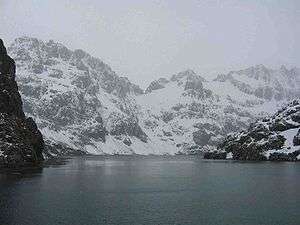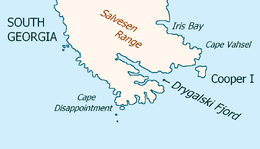Anthony de la Roché



Anthony de la Roché, born sometime in the 17th century, (spelled also Antoine de la Roché, Antonio de la Roché or Antonio de la Roca in some sources) was an English merchant born in London to a French Huguenot father and an English mother. During a commercial voyage between Europe and South America he was blown off course, and visited the Antarctic island of South Georgia, making the first ever discovery of land south of the Antarctic Convergence.[1]
1675 Voyage
Discovery of South Georgia
Having acquired a 350-ton ship in Hamburg and obtained permission by the Spanish authorities to trade in Spanish America, la Roché called at the Canary Islands in May 1674 and in October that year arrived in the port of Callao in the Viceroyalty of Peru by way of Le Maire Strait and Cape Horn. On his return voyage, sailing from Chiloé Island (Chile) to Bahia de Todos os Santos (Salvador, Brazil), in April 1675 la Roché rounded Cape Horn and was overwhelmed by tempestuous conditions in the tricky waters off Staten Island (Isla de los Estados). His ship failed to make Le Maire Strait as desired, nor round the east extremity of Staten Island (i.e. make the mythical 'Brouwer's Strait' present on the old maps since the 1643 Dutch expedition of Admiral Hendrik Brouwer), and was carried far away to the east instead. Eventually they found refuge in one of South Georgia's southern bays – possibly Drygalski Fjord according to some experts – where the battered ship anchored for a fortnight.
According to la Roché's report published in London in 1678[2] and its surviving 1690 summary, "they found a Bay, in which they anchored close to a Point or Cape which stretches out to the Southeast with 28. 30. and 40. fathoms Sand and Rock".[2][3] The surrounding glaciated, mountainous terrain was described as "some Snow Mountains near the Coast, with much bad Weather." Once the weather cleared up the ship set sail, and while rounding the southeast extremity of South Georgia they sighted Clerke Rocks further to the southeast.
Gough Island landing
Several days after his departure from South Georgia la Roché came across another uninhabited island, "where they found water, wood and fish", and spent six days "without seeing any human being", thus making what some historians believe was the first landing on the South Atlantic island that had been discovered by the Portuguese navigator Gonçalo Álvares in 1505 or 1506 (and known as Gough Island since 1731).[2][3][4]
La Roché successfully reached the Brazilian port of Salvador, and eventually arrived in La Rochelle, France on 29 September 1675.[2][5][6][7][8]
Legacy
Soon after the voyage cartographers started to depict on their maps Roché Island, and Straits de la Roche separating the island from an Unknown Land to the southeast, honouring the discoverer.
Captain James Cook was aware of la Roché's discovery, mentioning it in his ship journal upon approaching South Georgia in January 1775.[9] However, Cook made the first recorded landing, and surveyed and mapped Roché Island, renaming it for King George III in the process.[10]
The second ever map of South Georgia made in 1802 by Captain Isaac Pendleton of the American sealing vessel Union and reproduced by the Italian polar cartographer A. Faustini in 1906, was entitled South Georgia; Discovered by the Frenchman La Roche in the year 1675. (Pendleton erred regarding la Roché's nationality due to his French last name.)[11]
Maps showing la Roché's discovery
In particular, the newly discovered island appeared on the following 17th-18th century maps:
- J.T. Albernaz, J. de Attayde and F. de Seixas y Lovera. Mapas generales originales y universales des todo el orue con los puertos principales y fortalezas de Ambas Indias y una descripcion topographica de la region Austral Magallonica año de 1692. Published in 1630, appended in 1692.
- L'Isle, Guillaume de; J. Covens & C. Mortier. (1700/20). L'Amerique Meridionale. Paris.
- Chatelain, Henry A. (1705/19). Nouvelle Carte de Geographie de la Partie Meridionale de la Amerique. Amsterdam.
- L'Isle, Guillaume de & Henry A. Chatelain. (1705/19). Carte du Paraguai, du Chili, du Detroit de Magellan. Paris.
- Lens, Bernard & George Vertue. (ca. 1710). Map of South America. London.
- Price, Charles. (ca. 1713). South America corrected from the observations communicated to the Royal Society's of London and Paris. London.
- De Fer, Nicolas. (1720). Partie La Plus Meridionale de L'Amerique, ou se trouve Le Chili, Le Paraguay, et Les Terres Magellaniques avec les Fameux Detroits de Magellan et de le Maire. Paris.
- Homann Heirs. (1733). Typus Geographicus Chili a Paraguay Freti Magellanici. Nuremberg.
- Moll, Herman. (1736). A map of Chili, Patagonia, La Plata and ye South Part of Brasil. London.
- L'Isle, Guillaume de & Girolamo Albrizzi. (1740). Carta Geografica della America Meridionale. Venice.
- Seale, Richard W. (ca. 1745). A Map of South America. With all the European Settlements & whatever else is remarkable from the latest & best observations. London.
- Cowley, John. (ca. 1745). A Map of South America. London.
- Gibson, John. (1753). South America. London.
- Buache, Philippe. (1754). Carte des Terres Australes, Comprises entre le Tropique du Capricorne et le Pôle Antarctique. Paris.
- Jefferys, Thomas. (1768). South America. London.
- Robert de Vaugondy, Didier. (1777). Hemisphère Australe ou Antarctique. Paris.
- Arrowsmith, Aaron. (1794). Map of the World on a Globular Projection, Exhibiting Particularly the Nautical Researches of Capn. James Cook, F.R.S. with all the Recent Discoveries to the Present Time. London.
 Fragment of Seale's map (ca. 1745) featuring Roche Island |
1802 Map of South Georgia (Cpt. Isaac Pendleton) |
Honours
Roché Peak, the highest feature on Bird Island, South Georgia, and Roché Glacier in Vinson Massif, Antarctica are named for Anthony de la Roché.[12][13]
See also
References
- ↑ Headland, Robert K. (1984). The Island of South Georgia, Cambridge University Press. ISBN 0-521-25274-1
- 1 2 3 4 Capt. Francisco de Seixas y Lovera, Descripcion geographica, y derrotero de la region austral Magallanica. Que se dirige al Rey nuestro señor, gran monarca de España, y sus dominios en Europa, Emperador del Nuevo Mundo Americano, y Rey de los reynos de la Filipinas y Malucas, Madrid, Antonio de Zafra, 1690. (Narrates the discovery of South Georgia by the Englishman Anthony de la Roché in April 1675 (Capítulo IIII Título XIX page 27 or page 99 of pdf); Relevant fragment.)
- 1 2 J.-F.G. de la Pérouse, F.A.M. de la Rúa. A Voyage Round the World, Performed in the Years 1785, 1786, 1787, and 1788, by the Boussole and Astrolabe: Under the Command of J.-F.G. de la Pérouse, Volume 1. London: Lackington, Allen, and Company, 1807. pp.71-81.
- ↑ Wace, Nigel Morritt. (1969). The discovery, exploitation and settlement of the Tristan da Cunha Islands. Proceedings of the Royal Geographical Society of Australasia (South Australian Branch) 10: 11–40.
- ↑ Dalrymple, Alexander. (1771). A Collection of Voyages Made to the Ocean Between Cape Horn and Cape of Good Hope. Two volumes. London.
- ↑ Matthews, L. Harrison. (1931). South Georgia: The British Empire's Sub-Antarctic Outpost. Bristol: John Wright; and London: Simpkin Marshall.
- ↑ Headland, Robert K. (1990). Chronological List of Antarctic Expeditions and Related Historical Events. Cambridge University Press. ISBN 0-521-30903-4
- ↑ Capt. Ferrer Fougá, Hernán. (2003). El hito austral del confín de América. El cabo de Hornos. (Siglos XVI-XVII-XVIII). (Primera parte) Archived 10 August 2011 at the Wayback Machine.. Revista de Marina, Valparaíso, N° 6.
- ↑ Cook, James. (1777). A Voyage Towards the South Pole, and Round the World. Performed in His Majesty's Ships the Resolution and Adventure, In the Years 1772, 1773, 1774, and 1775. In which is included, Captain Furneaux's Narrative of his Proceedings in the Adventure during the Separation of the Ships. Volume II. London: Printed for W. Strahan and T. Cadell. (Relevant fragment)
- ↑ Cook, James. (1777). Chart of the Discoveries made in the South Atlantic Ocean, in His Majestys Ship Resolution, under the Command of Captain Cook, in January 1775. W. Strahan and T. Cadel, London. (Relevant fragment)
- ↑ Faustini, Arnaldo. (1906). Di una carta nautica inedita della Georgia Austral. Revista Geografica Italiana, Firenze, 13(6), 343–51.
- ↑ Roché Peak. Geographic Names Information System (GNIS)
- ↑ Roché Glacier. SCAR Composite Antarctic Gazetteer
